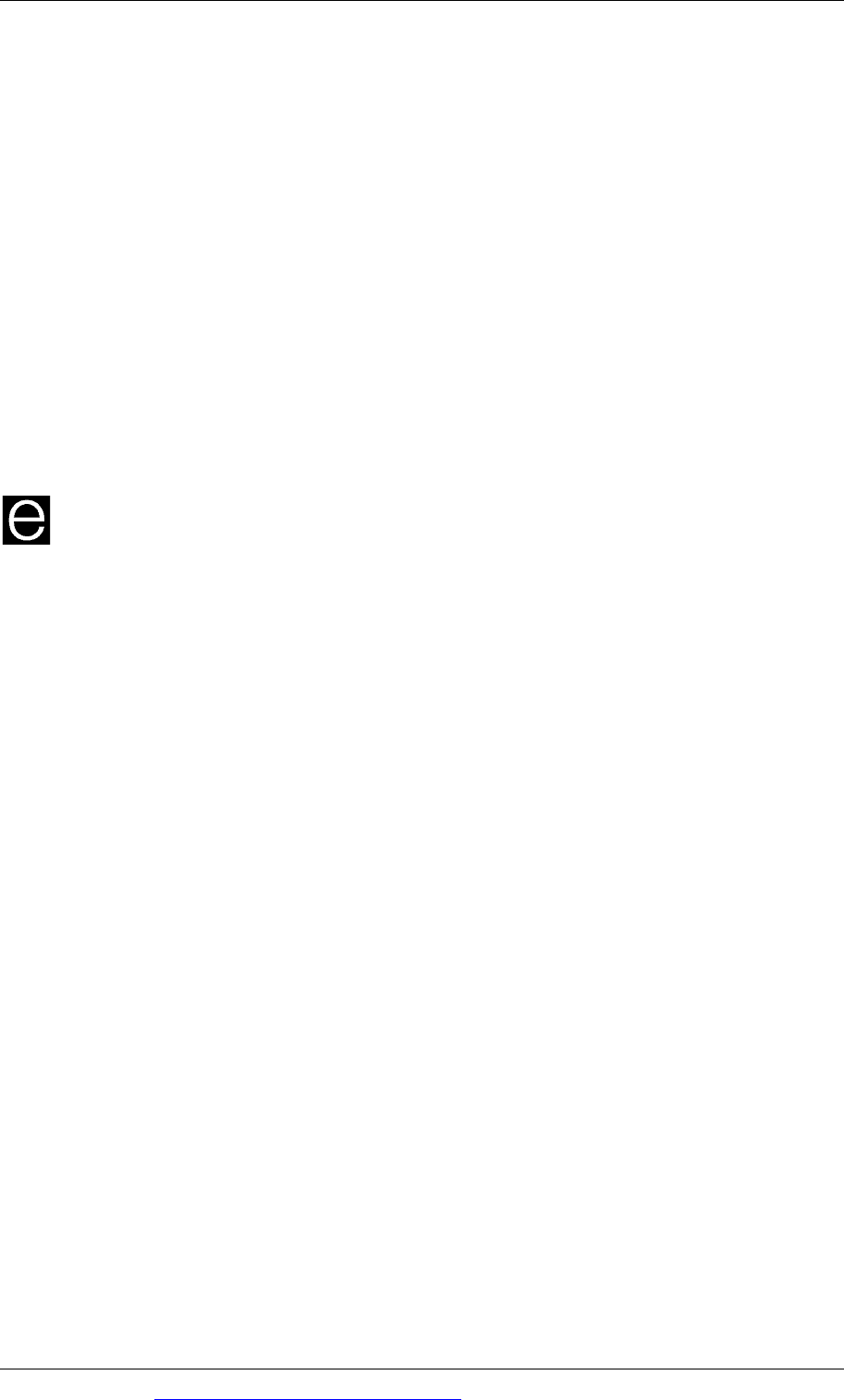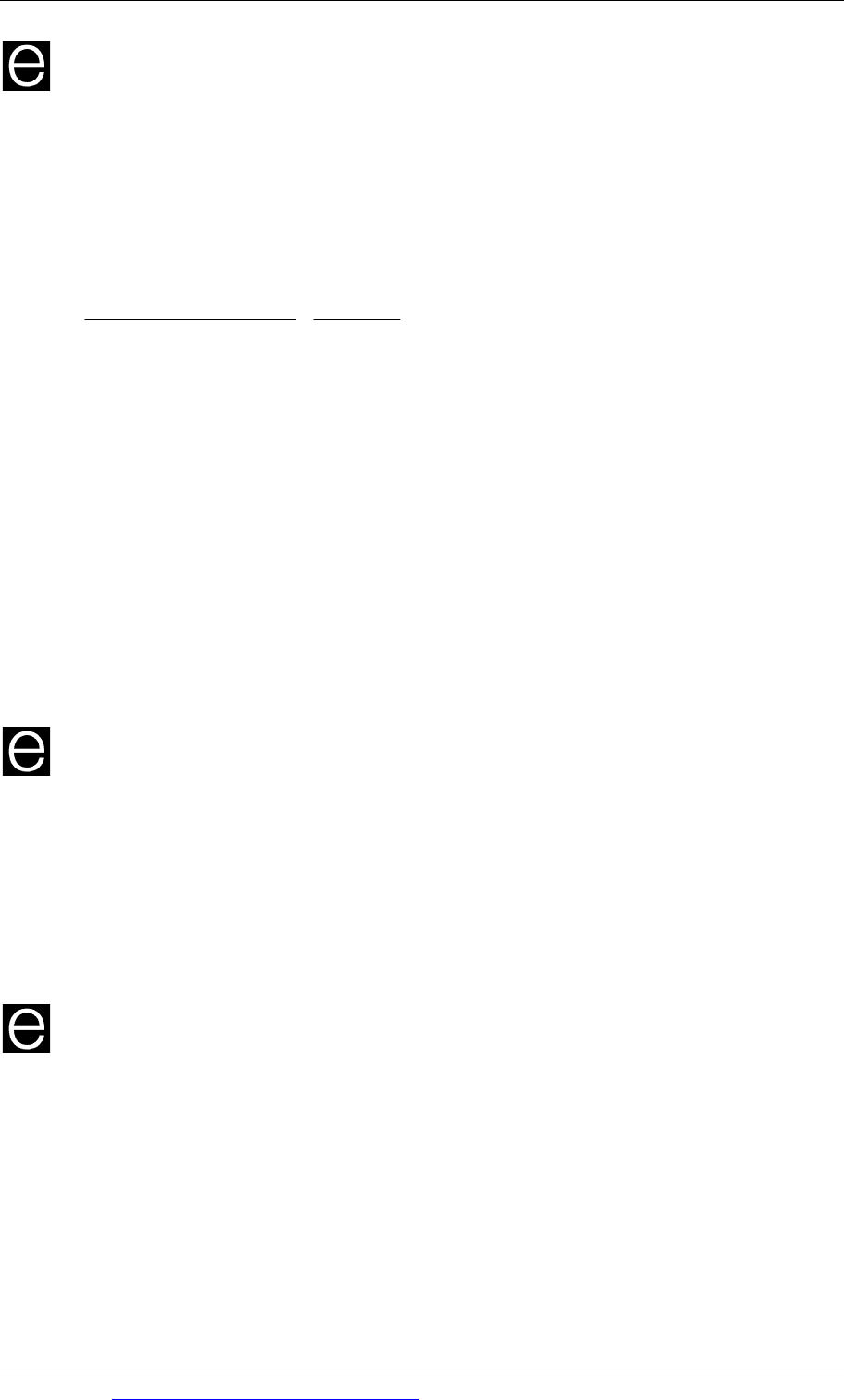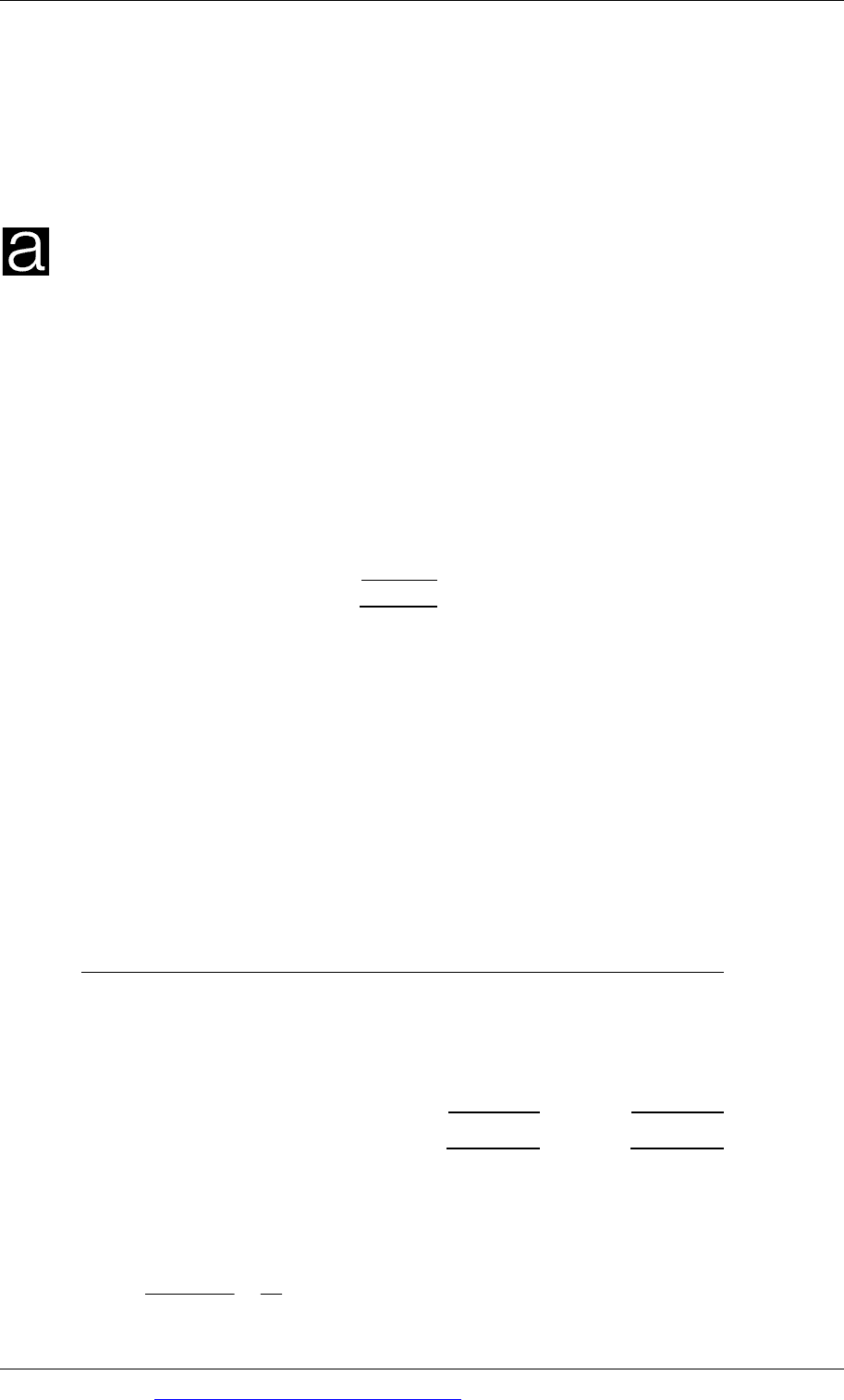ACCA F9 Financial Management - 2010 - Study text - Emile Woolf Publishing
Подождите немного. Документ загружается.


Chapter 20: Interest rate risk
© EWP Go to www.emilewoolfpublishing.com for Q/As, Notes & Study Guides 425
Swaptions
A swaption is an option on a swap. It gives its holder the right, but not the
obligation, to enter into a swap agreement at a future date, on terms that are fixed
now.
Swaptions are not commonly used, particularly by companies, because of the cost of
the option premium.
Caps, floors and collars
A borrower’s option is an option on the interest rate for a short-term loan and a
lender’s option is similarly an option on the interest rate for one notional short-term
deposit.
Some companies might want to hedge their interest rate risk on longer-term bank
loans, where they are paying a variable interest rate on the loan over a period of
several years. The interest rate on the loan is re-set regularly, typically every three or
six months. For example a company might borrow $20 million for five years, with
interest payable at LIBOR + 0.50%, and the interest rate re-set every three months in
line with changes in the market (spot) LIBOR rate.
The company might want to hedge its exposure to the risk of an increase in LIBOR
over the term of the loan, and might want to use options to fix a maximum rate for
the borrowing. A single borrower’s option will not be sufficient to enable the
company to hedge its interest rate risk over the full term of the loan. Instead, the
company can arrange an interest rate cap.
An
interest rate cap is a series of borrower’s options. The exercise date for each
option can be scheduled to coincide with the date that the interest rate on a variable
rate loan is re-set. In the example, an interest rate cap could be purchased by the
company giving it a series of borrower’s options over the five-year term of its loan.
The options would be timed to coincide with the interest rate re-set dates for the
loan – the first after six months, the next after one year, the next after 18 months and
so on. In this way, the company is able to fix a maximum effective rate on its
borrowing over the full term of the bank loan.
An
interest rate floor is similar in concept to a cap, except that it is a series of
interest rate put options. It gives its holder the right to fix a minimum interest rate
for deposits over a period of time.
The main disadvantage of interest rate caps and floors is the high cost charged for
the premium by the bank writing the option. The high cost of the premium can
discourage companies from using caps to fix a maximum borrowing cost.
An
interest rate collar is an alternative product for which the cost of the premium is
lower. When used instead of an interest rate cap it:
fixes a maximum interest rate for borrowing over the full term of the option,
which might be for several years (in the same way as for a cap), but

Paper F9: Financial management
426 Go to www.emilewoolfpublishing.com for Q/As, Notes & Study Guides © EWP
unlike a cap, it also fixes a minimum borrowing cost. If the LIBOR rate falls
below a floor level, the option holder will be obliged by the option writer (the
bank) to borrow for the interest period at the higher floor rate.
4.6 Short-term interest rate futures (STIRs)
Futures were described in the previous chapter. They are exchange-traded forward
contracts. Futures on short-term interest rates are traded extensively, particularly by
banks, but could be used by non-bank companies are a means of hedging short-term
interest rate risk (i.e. hedging exposures to changes in the near future in a short-term
interest rate such as LIBOR).
A short-term interest rate future (STIR) is a contract for the purchase and sale of a
standard notional deposit, usually a three-month bank deposit. It has many
similarities with a forward rate agreement (FRA), the main difference being that
FRAs are ‘over-the-counter’ products whereas futures are exchange-traded.
The most commonly-traded STIRs include the following:
Contract
Underlying amount
= three-month deposit of:
Eurodollar US$1,000,000
Euribor €1,000,000
Short sterling £500,000
Prices
The futures price for STIRs is the annual interest rate. It is the interest rate at which
the seller of the future agrees to ‘sell’ the notional three-month deposit to the buyer
of the futures. However, the rate is deducted from 100, which means that:
a rate of 4% per year is indicated by a futures price of 96.0000 (100 – 4)
a rate of 5.2175% is indicated by a futures price of 94.7825
a price of 93.5618 represents an annual interest rate for the three-month deposit
of 6.4382%.
For example, if a company sells a March eurodollar future at 96.50, it is selling to the
buyer of the future a notional three-month deposit of $1,000,000, starting in March,
on which the interest rate is 3.5%. The seller therefore will receive 3.5% and the
buyer of the future will pay 3.5%. In practice, like FRAs, interest rate futures are not
settled by the provision of an actual deposit of $1,000,000. They are cash settled for
the difference between the price at which the future was sold/bought and the
current reference rate of interest (LIBOR) at the settlement date.
A reason for pricing STIRs at 100 less the interest rate is that:
when interest rates go up, the market value of the future will fall, and
when interest rates fall, the price of the future will rise.

Chapter 20: Interest rate risk
© EWP Go to www.emilewoolfpublishing.com for Q/As, Notes & Study Guides 427
In this way, prices for STIRs move in the same way as cash market prices for bonds
and other interest products.
4.7 Hedging short-term interest rate exposures with STIRs
STIRs can be used to hedge exposures to the risk of a rise or fall in short-term
interest rates between the time the future is sold or bought and the settlement date
for the future. Most STIRs are traded for settlement dates within the next six months
or so. Using short-term interest rate futures is similar to using currency futures to
hedge a currency exposure. However, the following rules need to be applied:
If the aim is to hedge against the risk of an increase in the short-term interest
rate, the hedge is created by
selling futures. If the interest rate does go up,
futures prices will fall, and there will be a profit on the short position in STIRs
If the aim is to hedge the risk of a fall in the short-term interest rate, the hedge is
created by
buying futures.
Example
It is February. A company intends to borrow £10 million in June for three months
and for simplicity it is assumed that the company can borrow at the LIBOR rate. It
decides to hedge its exposure to a rise in the LIBOR rate between ‘now’ and June by
selling June sterling interest rate futures. Suppose the selling price for the futures is
94.00 (= 6%).
When the futures reach their settlement date in June, the actual LIBOR rate might be
7.5%. If so, the company will borrow £10 million at 7.5%. However, in settlement of
its futures position, it has sold notional deposits at 6% and on settlement buys them
back at the current LIBOR rate of 7.5%, giving itself a 1.5% profit on the futures
trading. Its net effective interest cost for the next three months is therefore 7.5% -
1.5% = 6%, which is the rate at which it sold the futures in February.
If the LIBOR rate at settlement in June had been 5.5%, the company would have
borrowed for thee months at 5.5% but would have made a loss on settlement of its
futures position. The loss would be 0.5% (= 6% - 5.5%) and so its effective interest
cost for the next three months would be 5.5% + 0.5% loss = 6% - the rate fixed by the
sale of the futures in February.
Number of futures for a hedge
If a company knows that it will need to borrow $20 million for three months in
September, and that the borrowing rate will be linked to dollar LIBOR, it can sell
September futures. Since each future is for a three-month deposit of $20 million, it
will need to sell 20 September futures.
Short-term interest rate futures are futures for three-month deposits. If a company
wishes to hedge an interest rate risk for a different interest period, such as two
months, four months or six months, the number of futures to create the hedge
should be adjusted by a factor:
(Interest period to be hedged/3 months).

Paper F9: Financial management
428 Go to www.emilewoolfpublishing.com for Q/As, Notes & Study Guides © EWP
Example: number of futures for the hedge
It is now the end of October. A company expects to borrow $5 million for six
months from February, in four months’ time and is concerned about the risk of a
rise in the eurodollar interest rate. It decides to hedge the exposure with eurodollar
futures. Each eurodollar future is for a three-month deposit of $1,000,000.
The company will hedge the position by selling March futures. The number of
contracts required for the hedge for a six-month loan is:
$5,000, 000
$1,000, 000 per contract
×
6 months
3 months
=10 contracts
If changes in the three-month interest rate and changes in the six-month interest rate
are similar during the period that the hedge is in place, hedging with three-month
STIRs will be an effective method of hedging exposures to movements in the six-
month interest rate.
Closing a futures position before settlement
The previous chapter explained how sellers or buyers of futures can close their
futures position before their settlement date. For example a seller of December
futures can close the position by purchasing the same number of December futures
at any time before settlement date in December.
On closing a futures position, there is a gain or loss on the futures trading, equal to
the difference between the buying and selling prices.
Example: hedging with short-term interest rate futures
In July a company bought 10 December Eurodollar STIRs at 96.00. In November it
closed its position by buying 10 December futures at 95.40.
It makes a profit on closing the position, because the buying price is less than the
selling price by 0.60%. Since a future involves the sale of a notional deposit of
$1,000,000 for three months, the value of the profit on futures trading for each future
is 0.60%
× $1,000,000 × 3/12 = $1,500. The total profit on 10 futures is therefore
$15,000.
Example: hedging with short-term interest rate futures
A company will need to borrow 8 million euros from the end of May. It is now
January. The company is concerned about the risk of a rise in the euribor rate (the
benchmark interest rate for the euro) and it wishes to hedge its position with
futures. The current spot euribor rate is 3.50% (for both three months and six
months) and the current June euribor futures price is the same, 96.50.
Required:
(a) How should the company hedge its interest rate exposure if it plans to borrow
the 8 million euros for (1) three months or (2) six months?

Chapter 20: Interest rate risk
© EWP Go to www.emilewoolfpublishing.com for Q/As, Notes & Study Guides 429
(b) Suppose that in May when the company borrows the 8 million euros, the
three-month and six-month spot euribor rate is 4.25% and the June futures
price is the same, 95.75 (100 – 4.25). Calculate the effective annual interest rate
that the company has secured with its futures hedge if it borrows the 8 million
euros for (1) three months or (2) six months.
Answer
The exposure is to the risk of a rise in the euribor rate. Therefore the company
should:
sell 8 June euribor futures (€8,000,000/€1,000,000 per contract) if it is hedging a
three-month loan exposure, and
sell 16 June contracts (8 contracts × 6 months/3 months) if it is hedging a six-
month loan exposure.
In May, the futures position will be closed. The selling price is 95.75.
Open futures position: sell at 96.50
Close position: buy at 95.75
Gain 00.75
Gain = 0.75% per contract.
Total gain on futures position:
(a) Hedging the three-month rate = 8 contracts × 0.75% ×
€1,000,000 × 3/12 =
€15,000.
(b) Hedging the six-month rate = 16 contracts × 0.75% ×
€1,000,000 × 3/12 =
€30,000.
The company will borrow 8 million euros at 4.25%.
(a)Hedgingthe
three‐monthrate
(b)Hedgingthe
six‐monthrate
€ €
Interestcost:€8million×3/12×4.25% 85,000
Interestcost:€8million×6/12×4.25% 170,000
Minusgainonfuturesposition (15,000) (30,000)
Neteffectivecost 70,000 140,000
The net effective cost can be converted into an effective annual interest rate that has
been achieved by the hedge with futures.
(a)
Net effective interest rate for hedge of three-month rate =
70,000
8,000, 000
⎛
⎝
⎜
⎞
⎠
⎟
×
12
3
= 0.035 or 3.50%.

Paper F9: Financial management
430 Go to www.emilewoolfpublishing.com for Q/As, Notes & Study Guides © EWP
(b) Net effective interest rate for hedge of six-month rate =
140,000
8,000, 000
⎛
⎝
⎜
⎞
⎠
⎟
×
12
6
= 0.035 or 3.50%.
This hedge against interest rate using futures therefore fixes the effective interest
rate at the interest rate when the futures position was opened.
Difficulties with short-term interest rate futures as a method of hedging risk
A problem with short-term interest rate futures as a method of hedging interest rate
risk is that it is often difficult to arrange a ‘perfect hedge’.
Futures contracts are for standard quantities of notional deposits. The amount of
a loan that needs to be hedged might not be a convenient multiple of the size of
interest rate futures. For example, to hedge the interest rate on a future three-
month loan of $11.5 million, a company would need to sell either 11 futures ($11
million) or 12 futures ($12 million). It cannot sell 11.5 futures.
Positions in futures contracts are normally closed before settlement date for the
contract, and there is a gain or loss on closing out the position. However futures
prices are not the same as the current spot interest rate until settlement date is
reached. The gain or loss on closing a futures position is therefore not exactly the
same as the difference between the original futures price (to open the futures
position) and the spot market interest rate on the date the position is closed.
Because STIRs do not provide a perfect hedge, companies that choose to hedge
exposures to changes in short-term interest rates in the near future are more likely
to do so with FRAs rather than STIRs.
4.8 Conclusion: using financial derivatives
This chapter and the previous chapter have both tried to explain how financial
futures might be used to hedge interest rate risk or currency risk.
In practice, swaps, options and futures are used mainly by banks and other financial
and investment institutions, although they are sometimes used by other companies.
Non-bank companies are likely to prefer other methods of hedging exposures to
risk, including forward contracts (forward exchange contracts and FRAs).
A final point to note is that although derivatives can be used to hedge risk, they can
also be used to speculate and try to make profits on movements in the prices of
financial items such as currency rates and interest rates.
In the case of options, option writers hope to profit by receiving the option premium
and hoping that the option will not be exercised at expiry (or if the option is
exercised, its ‘loss’ on exercise is less than the premium income it has received).
Options are a ‘zero sum game’ in which the option writer makes a profit only if the
option buyer makes a loss.
In the case of futures, a company (or bank) might expose itself to risk by opening up
a large position in currencies, interest rates or share prices, hoping to make a large

Chapter 20: Interest rate risk
© EWP Go to www.emilewoolfpublishing.com for Q/As, Notes & Study Guides 431
profit from favourable price movements – but with the risk of making large losses of
the market price moves adversely.
This is why companies that allow their treasury department to make some
speculative deals in derivatives need to set ‘dealing limits’ or ‘exposure limits’ on
how much speculative trading they are allowed.

Paper F9: Financial management
432 Go to www.emilewoolfpublishing.com for Q/As, Notes & Study Guides © EWP

© EWP Go to www.emilewoolfpublishing.com for Q/As, Notes & Study Guides 433
Paper F9
Financial management
A
Answers to exercises
Chapter 6: Cash management
Exercise 1
05.0
000,000,162502 ××
= $400,000.
Exercise 2
Miller-Orr model exercise
Daily interest rate
=
365
1.07
()
−1 = 0.000185
()
3
1
2
4
3
/
000185.0
800,1120/
3Spread
⎥
⎦
⎤
⎢
⎣
⎡
××
×=
= 3 × $11,638
= $34,914.
(a) The upper limit = $40,000 + $34,914 = $74,914, say $75,000.
(b) The return point = $40,000 + $11,638 = $51,638. This may be rounded to
$51,500 or $52,000.

Paper F9: Financial management
434 Go to www.emilewoolfpublishing.com for Q/As, Notes & Study Guides © EWP
Chapter 7: Introduction to investment appraisal and capital investment
decisions
Exercise 1
Totalcashprofits:
$
Years1–3(3×$66,000) 198,000
Years4–6(3×$42,000) 126,000
324,000
Lessdepreciationoversixyears(240,000–24,000) 216,000
Totalprofits 108,000
Averageannualprofit($108,000/6) $18,000
(a)
ARR =
$18,000
$240,000 +$40,000
()
×100% = 6.4%
(b)
$
Startingvalueoftheequipment 240,000
ValueoftheequipmentattheendofYear6 24,000
264,000
Averagecapitalemployedintheequipment(÷2) 132,000
Workingcapital 40,000
Averageinvestment 172,000
ARR =
$18,000
$172,000
×100%=10.5%
(c) A project should not be undertaken on the basis of its ARR.
Exercise 2
ProjectA ProjectB
Year
Cashflow
Cumulative
cashflow Cashflow
Cumulative
cashflow
$ $ $ $
0 (80,000) (80,000) (80,000) (80,000)
1 20,000 (60,000) 60,000 (20,000)
2 36,000 (24,000) 24,000 4,000
3 36,000 12,000
(1) If cash flows occur at the end of each year, Project A will pay back after three
years and Project B will pay back after two years.
